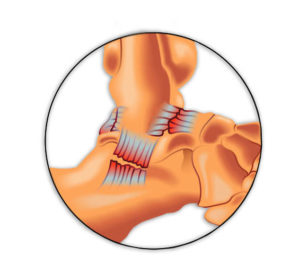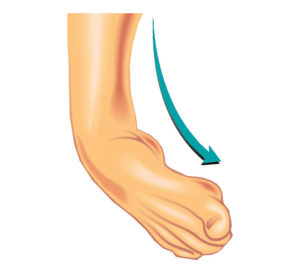What is a Sprained Ankle?

A sprained ankle is an injury that occurs when you twist, roll, or turn your ankle in an uncomfortable position. Twisting your ankle can stretch or tear the ligaments that help bind your ankle bones.
These ligaments help to stabilize joints. An ankle sprain occurs when the ligaments are stretched beyond their ability. When you hear of a sprained ankle, it involves the ligament on the outside of the ankle.
The severity of the sprain will determine the treatment method. It is possible, however, for you to only need over the counter medications. Although it’s always a good idea to seek medical attention. The sprain could be worse than you realize, and putting unnecessary pressure could make it worse.
Ankle Sprain Signs & Symptoms
Symptoms and signs of a sprained ankle may include:
- Pain, when you bear weight on the affected foot
- Tenderness when you touch the ankle
- Bruising
- Swelling
- Restricted range of motion
- Ankle instability
- Popping sound at the time of injury
Causes & Risks of a Sprained Ankle

When a sprained ankle occurs, it is because your ankle is forced out of its normal position. Therefore, causing a partial or complete tear.
Sprained ankle causes may include:
- A fall causing a twisting motion
- Landing awkwardly on your foot after jumping or pivoting
- Walking or exercising on an uneven surface
- Someone stepping or landing on your foot during a sports activity
Certain risk factors could make you more likely to sprain your ankle, such as:
- Sports participation
- Uneven surfaces
- Prior ankle injury
- Poor physical condition
- Improper shoes
Sprained Ankle Treatment
An ankle sprain treatment depends on the severity of the injury. The treatment goals are as follows:
- Reduce pain and swelling
- Promote ligament healing
- Restore ankle function
Self-care
When caring for a sprained ankle at home, use the RICE method for 2-3 days, such as:
Rest. It’s important to avoid activities that cause you discomfort. Plus, your body needs rest to promote healing.
Ice: Use an ice pack every two-three hours while away for 15-20 minutes at a time.
Compression: Compression is ideal to stop the swelling. To do this, compress the ankle with an elastic bandage until the swelling subsides. Be careful not to cut off circulation.
Elevation: Elevating helps to also reduce swelling. Elevate your ankle about your heart, even at night. This will help by reducing the swelling by draining fluid from your ankle.
Surgery
In some cases, surgery is recommended. When surgery is performed, it is to do the following:
- repair a torn ligament
- reconstruct a ligament with nearby ligament tissue or a tendon
If you are experiencing a sprained ankle, call us at 888-409-8006.
OUR DOCTORS
Knee Specialists
Our teams of qualified and skilled physicians provide a personalized experience in a caring and comfortable environment to enhance the quality of life of our patients. Utilizing the latest medical technologies and treatments, our staff are committed to delivering convenient and valuable services to meet the needs of the community.
Sports injuries occur when playing indoor or outdoor activities or while exercising. And they are commonly caused by overuse. Children are at high risk for sports injuries. However, adults can get them too. Sports injuries can result from many different incidents, such as:
- Accidents
- Inadequate training
- Improper use of protective devices
- Insufficient stretching or warm-up exercises
Acute vs. Chronic Pain
There are two different types of sports injuries, acute and chronic. A sudden injury is called an acute injury, for example, a sprained ankle from an unexpected landing.
On the other hand, overuse of muscles or joints is called a chronic injury. After a sports injury, make sure to get examined by a doctor. It could be more severe than you realize.
For an examination after an injury, call the experts at Total Otho Center at 888-409-8006. Trust in an award-winning sports orthopedic specialist.
Common Sports Injuries:
- Ankle Sprain. A Sprained Ankle occurs from being forced out of its normal position. For example, a roll, twist, or turn in an awkward way could cause this.
- Hamstring Injury. This type of injury is common in runners, skaters, football, soccer, and basketball players. You’re likely to get a hamstring strain during activities that involve a lot of running, jumping, or sudden stopping and starting.
- Shin Splints. Shin splints are usually found in sports which require a lot of running. The pain is acute and in the shin and lower leg. It typically occurs on hard surfaces, such as a basketball court.
- ACL Tear. The anterior cruciate ligament (ACL) is located in the central part of the knee. So, these ligaments control the back and forth movements of your knee.
- Patellofemoral Pain Syndrome. Patellofemoral pain syndrome (aka runners knee) is a broad term used to describe pain in the front of the knee and around the patella, or kneecap. Problems with alignment of the kneecap and overuse from vigorous athletics or training are a common cause of the runner’s knee.
- Tennis elbow. Tennis elbow is a type of tendinitis. Tendonitis means swelling from overuse. It’s understandably mistaken that golfers and tennis players will get these conditions. Although, that is not the common reason for these injuries. A difference between these two conditions is that the tennis elbow affects the outer part of your elbow. And golfers elbow affects the inner.
Common Sports Injuries Treatment
When a sports injury happens, the first thing you should do is the RICE method. This method stands for rest, ice, compression, and elevation. The RICE method should be done within 24 – 36 hours of the injury. Furthermore, it is commonly used in mild sports injuries. In fact, using this method can help reduce swelling and prevent additional pain and bruising.
Another common sports injury treatment method is over the counter prescriptions to reduce swelling and provide pain relief.
Next, physical therapy is required for optimal healing. Depending on how severe the injury is and how well you do in PT, this might even steer you clear of surgery.
On the other hand, there are many different surgical options for sport’s injuries. However, depending on the severity and type of injury.
Seek Emergency Care
Seek emergency care if you are showing signs such as the following:
- Severe swelling and pain
- Visible lumps, bumps, or other deformities
- Popping or crunching sounds when you use the joint
- Weakness or inability to put weight on the joint
- Instability
OUR DOCTORS
Sports Medicine Doctor
Our sports medicine specialist has special training to restore function to injured patients so they can get moving again and back to sports as soon as possible. Sports medicine physicians are experts in preventing illness and injury in active people. Our sports medicine providers have experience workting with professional athletes.
